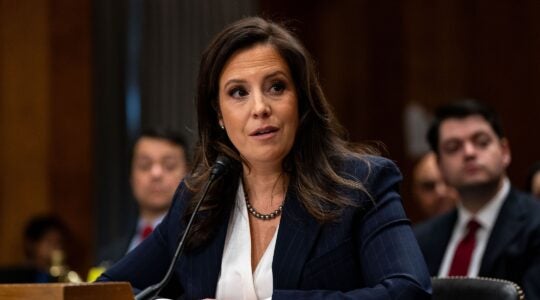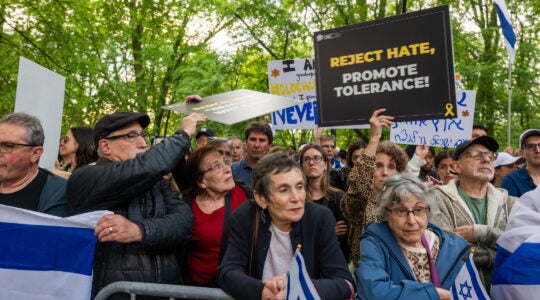NEW YORK (JTA) – This week’s decision by the U.S. Holocaust Memorial Museum to reference a controversial band of Jewish activists in its permanent exhibition is raising concern among some scholars over the role of outside pressure on the institution.
The museum announced Monday that it would modify its permanent exhibition to include a reference to the Bergson Group, a collection of activists whose public advocacy on behalf of European Jewry ran afoul of the milder sensibilities of the American Jewish leadership, which favored backroom lobbying.
Leading the push for the inclusion of the Bergson Group – with lobbying and petitions – was the David S. Wyman Institute for Holocaust Studies, a Washington group that has created a niche for itself in exploring the American response to the Holocaust.
“I don’t believe that you change things by petition,” said Deborah Lipstadt, a leading authority on Holocaust.denial who refused to sign the petition, but told JTA she agreed that the Bergson Group belonged in the permanent exhibit.
“You don’t politicize museums, especially a federal museum,” said Lipstadt, of Emory University.
The Wyman Institute’s director, Rafael Medoff, countered that his organization only went public after years of the museum failing to act.
“For more than five years we did exactly as Professor Lipstadt recommends – we handled this through private correspondence and private meetings and providing the museum with relevant documents about the Bergson Group,” Medoff told JTA.
The debate comes at a time when the museum is moving increasingly toward universalizing its message, using its platform and prestige to draw attention to contemporary instances of genocide like Darfur.
It is a move that is likely to grate on a small but vocal group of critics who have claimed that the museum pays insufficient attention to the growing danger of Arab anti-Semitism. The Bergson decision may serve to encourage the belief that public pressure can lead to changes at the museum.
“I would not like to see a situation where various interest groups seeking to establish their own interpretation as canonical can, through the mobilization of opinion and the collection of signatures, see the museum change,” said University of Toronto historian Michael Marrus, another scholar who declined to sign. “Museum professionals should be allowed to do their work professionally, without the kind of pressure that activists are sometimes brilliant at exerting.”
Whatever the criticism of the Wyman Institute’s tactics, several scholars agreed that the Bergson Group – named for its leader, who took the name Peter Bergson after arriving in the United States – merited a mention in the museum’s permanent exhibition.
The group took ads in major newspapers and organized public events calling for American intervention to save European Jewry from the Nazis. While their efforts were roundly condemned at the time by Jewish communal leaders, these days the consensus view of Bergson and his allies is far more sympathetic.
“I think in retrospect, much more than at the time, we respect the kinds of tactics that the Bergsonites used,” said Brandeis historian Jonathan Sarna. “Indeed, later on they would become normative tactics of the Jewish community.”
In the weeks before the museum’s decision, the Wyman Institute organized two petitions, including one signed by more than 100 scholars and Jewish leaders, urging the museum to incorporate Bergson into its permanent exhibition. At an institute-sponsored conference on the subject in June, Nobel laureate Elie Wiesel, a member of the council overseeing the museum, pledged to work for Bergson’s inclusion.
The museum, Medoff noted, already had acknowledged that Bergson merits mention within the context of the formation of the War Refugee Board, a U.S. government agency established to aid victims of the Nazis.
In a letter to Medoff in 2002, the museum’s curator, Steven Luckert, said the text panel on the War Refugee Board was slated for revision and would include reference to the Bergson Group’s role in its formation. It was only this year, nearly five years after the letter was sent, that the Wyman Institute went public.
This was not the first time the Wyman Institute publicly confronted a museum on a Holocaust issue. In 2005 it collected the signatures of 25 scholars on a petition calling on the Franklin D. Roosevelt Museum, another federally funded institution, to change a panel saying Roosevelt was virtually powerless to save Jews during World War II.
Medoff pointed to other examples of public pressure placed on museums. In 1995, the Smithsonian Institution scaled back an exhibit on the bombing of Hiroshima following complaints from war veterans. Last year the Vatican ambassador to Israel publicly criticized Yad Vashem for a caption stating that Pope Pius XII was silent in the face of the Nazi murder of European Jews.
The Holocaust Museum contends that changes to its permanent exhibition are not quickly or easily implemented. Beyond verifying the historical accuracy of new information, it takes time to design new panels and incorporate relevant artifacts and photographs. The museum also says it must take care to ensure the narrative flow of the exhibition is preserved.
But a museum spokesman, Andrew Hollinger, told JTA that no other adjustments were needed as a result of the Bergson addition.
In the meantime, the museum has beefed up the material on Bergson available on its Web site, which in 2006 was visited by 15 million people, more than half the total number of visitors to the physical museum in its 14-year history.
Part of what animates the critics is the concern that the Wyman Institute may be motivated by something beyond pure scholarship.
“They sort of straddle the area between scholarship and activism,” Lipstadt said of the institute.
Marrus told JTA there is “an unspoken political dimension” to this debate, and the Wyman Institute is interested in glorifying an aggressive Jewish posture in the face of difficult situations.
Bergson was a product of the right-wing Revisionist Zionist movement associated with Vladimir “Ze’ev” Jabotinsky and Menachem Begin, though many of those who joined his effort were from the left. Jewish rightists have long argued that the liberal Jewish establishments which dominated in America and Israel, as well as Roosevelt, failed to do enough to rescue European Jews. In recent decades this view has gained wider traction within the Jewish community and academic circles.
Medoff rejected the claim that the Wyman Institute – which boasts support from across the political spectrum – was motivated by any sort of ideological agenda.
“The historical record demonstrates that the Bergson Group’s public protests were effective and that those mainstream Jewish groups that sought to utilize behind-the-scenes tactics did not influence the Roosevelt administration policy,” Medoff said. “This is what actually happened. These protests by the Bergson Group had real impact, while the quiet diplomacy approach simply did not work.”
Medoff added, “The lesson the Wyman Institute wants to teach is that the correct posture for all Americans is to speak out loudly against genocide, whether it’s in Darfur or anywhere else.”
JTA has documented Jewish history in real-time for over a century. Keep our journalism strong by joining us in supporting independent, award-winning reporting.





